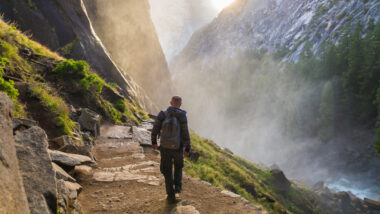Table of Contents Show
There’s nothing better than a hot shower after a day of adventuring. However, in an RV, this means taking a navy shower. Don’t worry; you don’t have to enlist in the military for this type of bathing.
Want to save water and stay clean? Keep reading! Today, we’re diving into this unique bathing style popular with environmentalists and RVers.
Whether you call it a navy, military, or combat shower, it’s all the same. It’s a way of bathing that conserves water and resources in short supply. As you might expect, the less time spent running the water, the better.
Since the goal is to use as little H2O as possible, they shut it off when it’s not needed. By turning it off while lathering and shampooing, they can significantly reduce how much they use.
The term became associated with the United States Navy due to the need to conserve water and energy on ships. However, it’s become popular with conservationists and those practicing sustainable living.
Navy showers are very effective for getting clean and reducing waste. A standard showerhead uses approximately 2.5 gallons per minute.
If you take eight to 10 minutes to rinse off, that’s 20 to 25 gallons. Those who practice this unique bathing style can use as little as two gallons.
Over the year, this can add up considerably. It could result in saving more than 8,000 gallons of water per person. For a family of four or five, that’s 32,000 to 40,000 gallons. Not only will your utility bills drop, but you’ll help the environment too.
As long as you lather and rinse thoroughly, this style of bathing is equally as effective as a standard one. While there’s not much better than a long, hot shower at the end of the day, that’s not always possible.
One of the biggest reasons to shower this way is to conserve water. It’s a popular bathing style for those who enjoy off-grid living. These individuals typically have to make every drop last as long as possible.
Those in the RV community that use this method must make their freshwater tank last. Some smaller campers may only carry 15 to 30 gallons.
This can go very fast if you’re not careful and mindful of your usage. However, it’s not just RVers; individuals in all types of lifestyles use this type of shower.
Taking a navy shower is relatively easy to do. Let’s walk through the steps you need to follow to save water while still staying fresh.
Get Undressed
Just like any other shower, you will need to undress. Depending on where you shower, ensure you have everything you need. If you wait to check until you’re in the buff, you may have to put your clothes back on.
Remember to put your clothing and other accessories somewhere safe. You don’t want them to get wet or have anything happen to them while you’re freshening up.
Keep in Mind: Before you use a campground shower, make sure you avoid making these 5 Mistakes!
Climb in the Shower
After undressing, it’s time to climb in the shower. If you’re in an unfamiliar shower, you’ll first want to adjust the temperature. You want to avoid getting in and discovering it’s too hot or cold.
Remember, the floor can be slippery when wet. Be careful when climbing in so you can avoid falling or getting hurt. If you’re in a public shower, you’ll likely want to wear rubber shoes to protect your feet. You never know what germs or fungi could live on the floor.
Get Wet and Turn off Water
Once in your navy shower, get your entire body wet as fast as possible. Make sure to soak every inch of your body. When done right, this should take 30 to 45 seconds. You can then shut off the water.
Many who regularly use this method use shower heads that feature on-off switches.
These allow them to stop the flow quickly without adjusting the temperature when they turn it back on. This reduces the chances of wasting water by waiting for it to get hot again.

Lather Up and Scrub
Now that you’re wet, start lathering and scrubbing. Just like an ordinary shower, use your preferred body wash and shampoo to get clean. Take your time and ensure you remember those hard-to-reach places.
Since you’re not running the water during this step of your navy shower, you don’t need to be in a hurry. Get as clean as possible.
Pro Tip: Taking care of your hygiene while on the road is essential. Check out these tips to help find Clean and Safe Public Showers!
Rinse Quickly and Turn off Water
After getting soapy, you need to rinse quickly. Turn the water back on and rinse off the soap suds as fast as possible.
However, not rinsing well could cause dryness and irritation. In addition, soap left in your hair can cause itchiness, dandruff, and buildup.
Depending on your bathing routine, you may need to repeat this process a time or two. Repeat as necessary if you have specific hair or skin care needs, rinse and turn off the water as quickly as possible.
Rinse your shampoo, then turn off the water. Put in your conditioner and wash your body. Then rinse off again.
When done correctly, a navy shower should take no more than a couple of minutes. The more you can do it, the faster you’ll get at it. Those who want to be as fast as possible may use combination soaps for hair and body. Why use multiple products when one can do the job?
Dry Off and Get Dressed
Once you complete your navy shower, you now need to dry off. Grab a soft towel and start patting down your body. You want to get as dry as possible to avoid dripping water everywhere.
Since you’re clean, you’ll also want to put on fresh clothes. If you want to head to bed soon, jump into your pajamas. If not, choose clothes appropriate for the occasion or weather conditions.

This eco-friendly bathing method is a great way to save water and time. You can stay fresh and clean even if you have limited resources or a tight schedule.
In addition to using less water, you’ll likely notice financial savings as well. Whether you use this method by choice or out of necessity, making it a part of your showering routine doesn’t take long.






